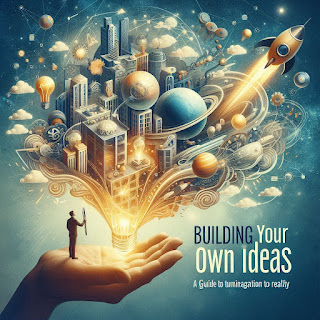Building Your Own Ideas: A Guide to Turning Imagination into Reality
In a world overflowing with information and innovation, the ability to generate and develop your own ideas is a powerful skill. Whether you're an aspiring entrepreneur, a creative artist, or simply someone looking to enhance their problem-solving abilities, learning how to build on your unique ideas can open up endless opportunities. Here's a guide to help you transform your thoughts into tangible outcomes.
●Nurture Curiosity and Observation
Every great idea starts with curiosity. The ability to ask questions, challenge the status quo, and observe the world around you is crucial. Take time to reflect on your interests and passions. Explore diverse fields, engage with different cultures, and stay updated with current trends. Keep a journal to jot down observations, thoughts, and questions that arise. These entries can serve as the seeds of your future ideas.
●Embrace Brainstorming Techniques
Brainstorming is a powerful technique for generating ideas. Here are a few approaches to get you started:
- **Mind Mapping**: Create a visual representation of your thoughts. Start with a central theme and branch out into related subtopics.
- **SCAMPER**: An acronym for Substitute, Combine, Adapt, Modify, Put to another use, Eliminate, and Rearrange. Use these prompts to look at your idea from different angles.
- **Reverse Thinking**: Instead of thinking about what you want to achieve, consider what you want to avoid. This can help highlight potential solutions.
●Research and Validation
Once you've brainstormed a list of potential ideas, it's time to dive into research. Understand the existing market, identify your target audience, and analyze competitors. Look for gaps or problems that your idea can address. Use surveys, interviews, and online forums to gather feedback. This validation process helps ensure that your idea has real-world viability.
●Prototype and Experiment
Creating a prototype is an excellent way to bring your idea to life. Depending on your field, this could be a physical model, a digital mock-up, or even a written plan. The goal is to create something tangible that you can test and refine. Don't be afraid of failure during this stage – each iteration brings you closer to a polished final product.
●Seek Feedback and Collaborate
Sharing your prototype with others can provide invaluable insights. Gather feedback from a diverse group of people, including potential users, mentors, and industry experts. Be open to constructive criticism and use it to improve your idea. Collaboration can also spark new perspectives and innovations. Consider forming a team with complementary skills to enhance your project's development.
●Develop a Strategic Plan
A well-thought-out plan is essential for turning your idea into a successful venture. Outline your goals, timelines, resources, and budget. Consider potential risks and how to mitigate them. This strategic planning phase ensures that you have a clear roadmap to follow and helps you stay focused on your objectives.
●Take Action and Iterate
The most critical step in building your idea is taking action. Start small, test your idea in the real world, and be prepared to adapt based on the results. Continuously iterate and improve your product or service. Remember that innovation is an ongoing process; what works today might need enhancements tomorrow.
●Communicate Your Idea
Effectively communicating your idea is crucial for gaining support and attracting potential customers or investors. Craft a compelling story that articulates the problem you're solving, your unique solution, and the benefits it offers. Utilize various communication channels, such as social media, blogs, and presentations, to reach your target audience.
●Stay Resilient and Persistent
Building an idea into reality is seldom a straightforward journey. There will be challenges, setbacks, and moments of doubt. Resilience and persistence are key attributes to keep moving forward. Learn from failures, celebrate small victories, and stay focused on your long-term vision.
●Keep Learning and Evolving
The world is constantly changing, and so should your ideas. Stay curious, keep learning, and be open to evolution. Attend workshops, read books, network with other innovators, and stay adaptable. The ability to pivot and embrace new insights will keep your ideas relevant and impactful.
●Conclusion
Building your own ideas is a dynamic process that requires curiosity, creativity, and commitment. By nurturing your interests, validating your concepts, seeking feedback, and staying resilient, you can transform your imagination into reality. Remember, every great idea started as a simple thought. With the right approach, you can turn your ideas into innovations that make a difference.
By following these steps, you'll be well on your way to developing your own ideas and transforming them into successful projects. Whether you're aiming for entrepreneurial success or personal fulfillment, the journey of building your ideas is both challenging and rewarding. So, go ahead and get started – the world is waiting for your next big idea.


Comments
Post a Comment